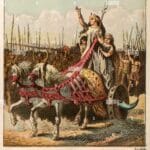In the hushed shadows of Jerusalem’s ancient walls, a towering enigma stands sentinel: Absalom’s Monument. Rising from the Kidron Valley floor, this intricately carved stone structure has captivated and perplexed historians and visitors alike for centuries. While tradition links it to the rebellious biblical figure Absalom, the monument’s true story is a far more intricate tapestry woven with architectural clues, historical debates, and enduring mysteries. Join us as we delve into the heart of this enigma, exploring its architectural marvels, debunking persistent myths, and piecing together the puzzle of Absalom’s Monument.
The Monument’s Conflicting Identities
A Name and a Narrative
The monument commonly known as Yad Avshalom (Absalom’s Memorial), or Absalom’s Pillar, takes its name from the biblical account of Absalom, the rebellious son of King David. According to 2 Samuel 18:18, Absalom, fearing his legacy would fade due to a lack of a male heir, erected a pillar for himself in the King’s Valley. This narrative has long been the foundation for the monument’s popular association with Absalom.
Architectural Clues and Chronological Conflicts
However, a closer inspection of the monument’s architectural style reveals a striking discrepancy. The distinct Doric frieze and Ionic columns point unequivocally to the Hellenistic or early Roman period (circa 3rd century BCE – 1st century CE), approximately a millennium after Absalom’s time (circa 10th century BCE). This stark chronological conflict immediately raises questions about the traditional narrative. Could this imposing structure, with its sophisticated architectural details, truly be the work of King David’s son? The evidence suggests a more nuanced and complex story.
A Byzantine Twist: The Inscription of Zechariah
Adding another layer of intrigue is a 4th-century Byzantine inscription found on the monument. This inscription identifies the structure as the “tomb of Zachariah, the martyr, the holy priest, the father of John.” This conflicting attribution further muddies the waters, raising the possibility that the monument has served different purposes and carried different meanings throughout its long history. Whose remains, if any, lie within? Was it a tomb, a cenotaph, or perhaps a symbolic marker? These are questions that continue to fuel scholarly debate.
Decoding the Architecture and Location
A Monolithic Marvel
Standing approximately 20 meters (66 feet) high and resting on a square base, Absalom’s Monument showcases a unique blend of construction techniques. The lower section, a monolithic cubical block measuring roughly 6 meters (20 feet) square by 6.4 meters (21 feet) high, is carved directly from the rock face of the Mount of Olives. Above this rises the upper section, meticulously constructed from precisely cut ashlar stones. This combination of rock-cut and ashlar construction speaks to the advanced engineering and craftsmanship of the era.
A Place Among the Dead: The Kidron Valley Necropolis
The monument’s location in the Kidron Valley, near other significant ancient tombs like the Tomb of Zechariah and the Tomb of Benei Hezir (https://www.lolaapp.com/boadicea-iceni and https://www.lolaapp.com/byra-louise-whittlesey), places it within a larger historical context. The Kidron Valley has long served as a prominent burial ground, particularly for Jerusalem’s elite. This placement suggests a funerary purpose for Absalom’s Monument, although the exact nature of that purpose remains open to interpretation. Was it intended for a single individual, a family, or perhaps as a symbolic marker for someone buried elsewhere? The valley holds its secrets close, offering tantalising glimpses into the past while leaving much shrouded in mystery.
Dispelling Myths and Embracing Nuance
Napoleon’s Phantom Attack
One persistent myth surrounding Absalom’s Monument claims that Napoleon bombarded the structure, damaging a hand-shaped ornament. This captivating tale, however, lacks any historical basis. Napoleon never set foot in Jerusalem, making his alleged attack an impossibility. Debunking such myths underscores the importance of relying on verifiable historical evidence and separating fact from fiction.
Embracing the Unknown
The story of Absalom’s Monument is a testament to the complexities of historical investigation. While definitive answers may remain elusive, the ongoing research and scholarly debate surrounding the monument offer valuable insights into the challenges of interpreting the past. By embracing the nuances and acknowledging the limits of our current knowledge, we can appreciate the monument not only for its architectural beauty but also for the intriguing questions it continues to pose. Perhaps future archaeological discoveries will shed more light on this enigmatic structure, but for now, it stands as a powerful reminder of the enduring mysteries of history.
- Red Cloud, NE: Discover Willa Cather’s Legacy - April 11, 2025
- Remember Old Social Media Sites? Their Rise and Fall - April 11, 2025
- How many days till Feb 3?Accurate Countdowns & Tools - April 11, 2025
















